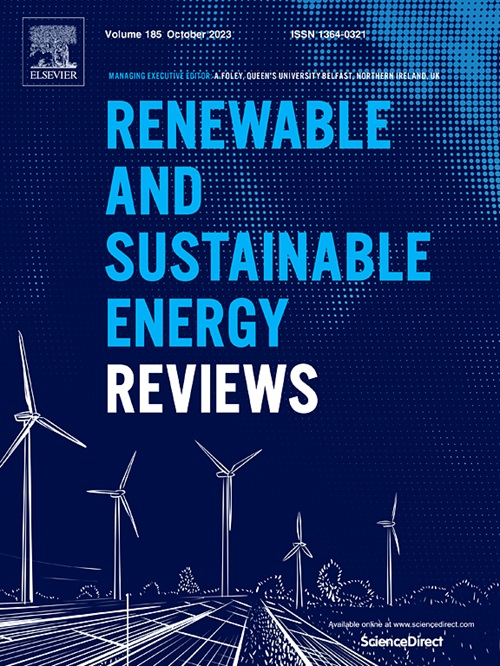Sustainability challenges and opportunities of shallow borehole geothermal systems
IF 16.3
1区 工程技术
Q1 ENERGY & FUELS
引用次数: 0
Abstract
Shallow Borehole Geothermal Systems (SBGSs) are gaining recognition as a low-carbon solution for sustainable heating and cooling, yet their widespread adoption remains limited by fragmented assessments and implementation barriers. This study presents a structured, multi-stage review of SBGS sustainability, integrating environmental, economic, social, technical, and policy dimensions. The methodology combines a broad exploratory scan of over 160 publications with a targeted analysis of 31 peer-reviewed articles published between 2010 and 2024, supported by more than 100 references to provide contextual data where direct metrics were unavailable. Litterature applications reveal that SBGSs can reduce CO2 emissions by 65–85 % compared to fossil fuel systems and yield energy savings of 26–50 % through ground source heat pumps. However, cost-effectiveness remains highly site-dependent, with initial investment and drilling expenses posing major barriers, particularly in dense urban areas. Social acceptance, legal clarity, and permitting delays further hinder deployment. To validate and apply the findings, a scenario-based case study of a hypothetical 10 MW community-scale SBGS project was developed. The case study integrates quantified indicators from all five sustainability dimensions and demonstrates the system's potential benefits and trade-offs under real-world constraints. This work offers a holistic and data-informed synthesis of SBGS sustainability and highlights the need for long-term performance monitoring, regulatory harmonization, and deeper engagement with social and economic contexts to support broader adoption and policy alignment across diverse geographical regions.
浅孔地热系统的可持续性挑战与机遇
浅孔地热系统(sbgs)作为一种可持续供暖和制冷的低碳解决方案正得到越来越多的认可,但其广泛采用仍然受到分散评估和实施障碍的限制。本研究从环境、经济、社会、技术和政策等方面对SBGS的可持续性进行了结构化的、多阶段的回顾。该方法结合了对160多篇出版物的广泛探索性扫描,以及对2010年至2024年间发表的31篇同行评议文章的针对性分析,并辅以100多篇参考文献,以提供无法获得直接指标的背景数据。文献应用表明,与化石燃料系统相比,sbgs可以减少65 - 85%的二氧化碳排放,通过地源热泵可以节省26 - 50%的能源。然而,成本效益仍然高度依赖于现场,初期投资和钻井费用构成了主要障碍,特别是在人口密集的城市地区。社会接受度、法律明确性和许可延迟进一步阻碍了部署。为了验证和应用这些发现,对一个假设的10兆瓦社区规模的SBGS项目进行了基于场景的案例研究。案例研究整合了所有五个可持续性维度的量化指标,并展示了该系统在现实世界限制下的潜在利益和权衡。这项工作为SBGS的可持续性提供了一个全面的、有数据依据的综合,并强调了长期绩效监测、监管协调以及更深入地参与社会和经济背景的必要性,以支持在不同地理区域更广泛地采用和政策协调。
本文章由计算机程序翻译,如有差异,请以英文原文为准。
求助全文
约1分钟内获得全文
求助全文
来源期刊

Renewable and Sustainable Energy Reviews
工程技术-能源与燃料
CiteScore
31.20
自引率
5.70%
发文量
1055
审稿时长
62 days
期刊介绍:
The mission of Renewable and Sustainable Energy Reviews is to disseminate the most compelling and pertinent critical insights in renewable and sustainable energy, fostering collaboration among the research community, private sector, and policy and decision makers. The journal aims to exchange challenges, solutions, innovative concepts, and technologies, contributing to sustainable development, the transition to a low-carbon future, and the attainment of emissions targets outlined by the United Nations Framework Convention on Climate Change.
Renewable and Sustainable Energy Reviews publishes a diverse range of content, including review papers, original research, case studies, and analyses of new technologies, all featuring a substantial review component such as critique, comparison, or analysis. Introducing a distinctive paper type, Expert Insights, the journal presents commissioned mini-reviews authored by field leaders, addressing topics of significant interest. Case studies undergo consideration only if they showcase the work's applicability to other regions or contribute valuable insights to the broader field of renewable and sustainable energy. Notably, a bibliographic or literature review lacking critical analysis is deemed unsuitable for publication.
 求助内容:
求助内容: 应助结果提醒方式:
应助结果提醒方式:


